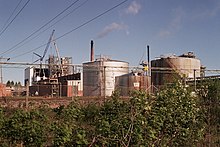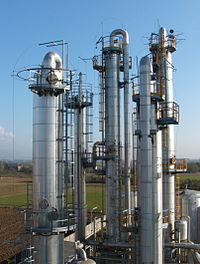Chemical plant
This article needs additional citations for verification. (March 2013) |

| Part of a series on |
| Chemical engineering |
|---|
| Fundamentals |
| Unit processes |
| Aspects |
| Glossaries |
|
|
A chemical plant is an
Chemical processes

Chemical plants use chemical processes, which are detailed industrial-scale methods, to transform feedstock chemicals into products. The same chemical process can be used at more than one chemical plant, with possibly differently scaled capacities at each plant. Also, a chemical plant at a site may be constructed to utilize more than one chemical process, for instance to produce multiple products.
A chemical plant commonly has usually large vessels or sections called units or lines that are interconnected by piping or other material-moving equipment which can carry streams of material. Such material streams can include fluids (gas or liquid carried in piping) or sometimes solids or mixtures such as slurries. An overall chemical process is commonly made up of steps called unit operations which occur in the individual units. A raw material going into a chemical process or plant as input to be converted into a product is commonly called a feedstock, or simply feed. In addition to feedstocks for the plant, as a whole, an input stream of material to be processed in a particular unit can similarly be considered feed for that unit. Output streams from the plant as a whole are final products and sometimes output streams from individual units may be considered intermediate products for their units. However, final products from one plant may be intermediate chemicals used as feedstock in another plant for further processing. For example, some products from an oil refinery may be used as feedstock in petrochemical plants, which may in turn produce feedstocks for pharmaceutical plants.
Either the feedstock(s), the product(s), or both may be individual compounds or mixtures. It is often not worthwhile separating the components in these mixtures completely; specific levels of purity depend on product requirements and process economics.
Operations
Chemical processes may be run in continuous or batch operation.
Batch operation
In batch operation, production occurs in time-sequential steps in discrete batches. A batch of feedstock(s) is fed (or charged) into a process or unit, then the chemical process takes place, then the product(s) and any other outputs are removed. Such batch production may be repeated over again and again with new batches of feedstock. Batch operation is commonly used in smaller scale plants such as pharmaceutical or specialty chemicals production, for purposes of improved traceability as well as flexibility. Continuous plants are usually used to manufacture
Continuous operation
In continuous operation, all steps are ongoing continuously in time.
Units and fluid systems
Specific

Fluid systems for carrying liquids and gases include piping and tubing of various diameter sizes, various types of
Chemical plant design

Today, the fundamental aspects of designing chemical plants are done by chemical engineers. Historically, this was not always the case, and many chemical plants were constructed haphazardly before the discipline of chemical engineering became established. Chemical engineering was first established as a profession in the United Kingdom when the first chemical engineering course was given at the University of Manchester in 1887 by George E. Davis in the form of twelve lectures covering various aspects of industrial chemical practice.[6] As a consequence George E. Davis is regarded as the world's first chemical engineer. Today chemical engineering is a profession and those professional chemical engineers with experience can gain "Chartered" engineer status through the Institution of Chemical Engineers.
In plant design, typically less than 1 percent of ideas for new designs ever become commercialized. During this solution process, typically, cost studies are used as an initial screening to eliminate unprofitable designs. If a process appears profitable, then other factors are considered, such as safety, environmental constraints, controllability, etc.[2] The general goal in plant design, is to construct or synthesize “optimum designs” in the neighborhood of the desired constraints.[7]
Many times
The units, streams, and fluid systems of chemical plants or processes can be represented by
In the plant design, the units are sized for the maximum capacity each may have to handle. Similarly, sizes for pipes, pumps, compressors, and associated equipment are chosen for the flow capacity they have to handle. Utility systems such as
Units and fluid systems in the plant including all vessels, piping, tubing, valves, pumps, compressors, and other equipment must be rated or designed to be able to withstand the entire range of pressures, temperatures, and other conditions which they could possibly encounter, including any appropriate
Within any constraints the plant is subject to, design parameters are optimized for good economic performance while ensuring the safety and welfare of personnel and the surrounding community. For flexibility, a plant may be designed to operate in a range around some optimal design parameters in case feedstock or economic conditions change and re-optimization is desirable. In more modern times, computer simulations or other computer calculations have been used to help in chemical plant design or optimization.
Plant operation
Process control
In
Workers
As in any industrial setting, there are a variety of workers working throughout a chemical plant facility, often organized into departments, sections, or other work groups. Such workers typically include engineers, plant operators, and maintenance technicians. Other personnel at the site could include chemists, management/administration, and office workers. Types of engineers involved in operations or maintenance may include chemical process engineers, mechanical engineers for maintaining mechanical equipment, and electrical/computer engineers for electrical or computer equipment.
Transport
Large quantities of fluid feedstock or product may enter or leave a plant by
Maintenance
In addition to feeding and operating the plant, and packaging or preparing the product for shipping, plant workers are needed for taking samples for routine and troubleshooting analysis and for performing routine and non-routine maintenance.
Statutory and regulatory compliance
When working with chemicals,
Clustering of commodity chemical plants
Chemical Plants used particularly for
Corrosion and use of new materials
See also
- Chemical industry
- Chemical process modeling
- FRP tanks and vessels- chemical process plant equipment made of FRP
- BS4994
- Electrical equipment in hazardous areas
- Instrumentation in petrochemical industries
- Chemical accident
- Chemical plant cost indexes
- Fine chemicals
- Speciality chemicals
- Petrochemical
- Northeast of England Process Industry Cluster
- Institution of Chemical Engineers
- S-graph
- Unit operations
References
- ^ Ellison-Taylor; et al. (1970). Chemical Plant Technology: An Introductory Manual. Longmans.
- ^ ISBN 978-0-07-017762-8.
- ^ Stork, William (2004). "Speciality Chemicals" (PDF). Chemical & Engineering News supplement 82. pp. 35–39.
- ^ Plant Construction Location Factor - Intratec Knowledge Base Archived 6 March 2014 at the Wayback Machine
- ^ NetSuite.com (29 June 2023). "Continuous Operations Explained". Oracle NetSuite. Retrieved 31 August 2023.
- ^ Delgass; et al. "Seventy Five Years of Chemical Engineering". Purdue University. Retrieved 13 August 2013.
- ^ Cussler, Moggridge and Moggridge (2001). Chemical product design. Cambridge University Press.
- ^ UK Trade&Investment. "Chemicals–the UK advantage" (PDF). pp. 9–10. Archived from the original (PDF) on 29 October 2013. Retrieved 10 July 2013.
- ISBN 978-1872339016.
Further reading
- ASME B73 Standards Committee, Chemical Standard Pumps
- Helmus, Frank P. (2008). Process plant design : project management from inquiry to acceptance. Weinheim: Wiley-VCH. ISBN 978-3527313136.
- Kletz, Trevor (2010). Process plants : a handbook for inherently safer design (2nd ed.). Boca Raton, FL: CRC Press/Taylor & Francis. ISBN 978-1439804551.
- Towler, Gavin; Ray Sinnott (2013). Chemical engineering design: principles, practice and economics of plant and process design (2nd ed.). Oxford: Butterworth-Heinemann. ISBN 9780080966595.
- Vogel, G. Herbert (2005). Process development : from the initial idea to the chemical production plant (1st ed., repr. ed.). Weinheim: Wiley-VCH. ISBN 978-3527310890.
- Max Stone Peters; Klaus Dieter Timmerhaus; Ronald Emmett West (2003). Plant design and economics for chemical engineers (5th ed.). New York: McGraw-Hill. ISBN 978-0072392661.
- Chemical Plant


